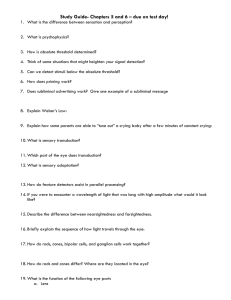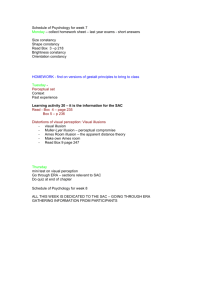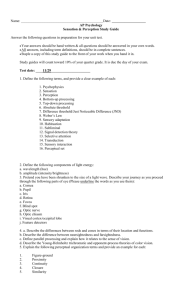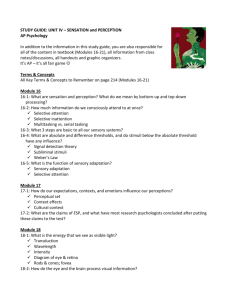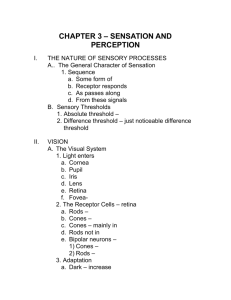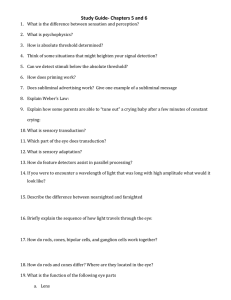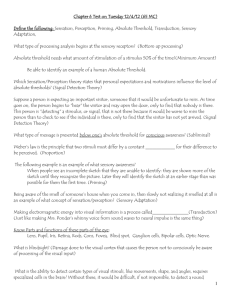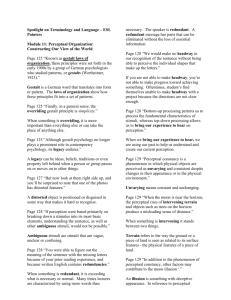Step Up To: Psychology
advertisement
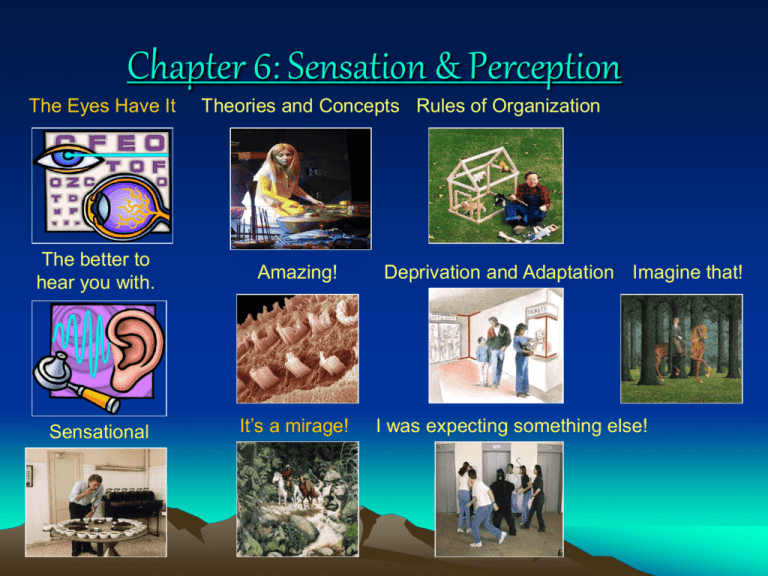
Chapter 6: Sensation & Perception The Eyes Have It Theories and Concepts Rules of Organization The better to hear you with. Amazing! Sensational It’s a mirage! Deprivation and Adaptation Imagine that! I was expecting something else! The Eyes Have It 500 400 300 200 100 The better to hear you with. 500 400 300 200 100 Sensational 500 400 300 200 100 Theories and Concepts 500 400 300 200 100 Amazing! 500 400 300 200 100 It’s a mirage. 500 30 400 300 200 27 100 Rules of Organization 500 400 34 300 200 100 Deprivation and Adaptation 500 40 400 39 300 200 100 I was expecting something else! 500 400 300 200 100 41 Imagine that! 500 400 300 200 100 1. Cones are different from rods in that: • A) rods respond to color and are located in the peripheral. • B) cones respond to black/white and are located in the peripheral. • C) rods respond to black/white and are located in the fovea. • D) cones respond to color and are located in the fovea. 2. The adjustable center of the eye that changes due to light is called ___. • • • • • A) fovea B) iris C) cornea D) pupil E) lens 3. The lens thins or thickens to focus light in a process known as: • • • • • A) visual sharpening. B) lens bending. C) accommodation. D) optic chiasm. E) assimilation. 4. Weber’s law has to do with the ___ of a stimulus. • • • • • A) absolute threshold B) just noticeable difference C) subliminal threshold D) sensory adaptation E) SDT matrix 5. If someone is severely damaged in the left visual cortex, they would be unable to see: • • • • • A) anything in their left eye. B) anything in their right eye. C) anything in their right visual field. D) anything in their left visual field. E) anything at all. 6. Frequency is to ___ as amplitude is to ___. • • • • • A) overtones; timbre B) loudness; pitch C) pitch; timbre D) decibels; hertz E) pitch; loudness 7. The sequence of hearing is in the order of: • A) eardrum, auditory canal, middle ear, inner ear. • B) cochlea, eardrum, middle ear, inner ear. • C) eardrum, middle ear, auditory canal, cochlea. • D) auditory canal, eardrum, middle ear, cochlea. 8. This accounts for the different sound qualities of the same note played by different instruments. • • • • • A) Intensity B) Frequency C) Pitch D) Timbre E) Loudness 9. The ___ has the sensory receptors for sound consisting of tiny, hair-like fibers. • • • • • A) ear canal B) stirrup C) basilar membrane D) tympanic membrane E) pinna 10. Sensorineural hearing loss (nerve deafness): • A) can be caused by viruses, diseases, and genetics. • B) can be completely corrected by a simple hearing aid. • C) is more likely the result of heavy traffic than by a rock concert. • D) can be caused by foreign object, ear wax, and malformation. • E) all of the above. 11. Which of the following senses is best described as a chemical sense? • • • • • A) touch B) vision C) audition D) kinesthesis E) smell 12. Receptor cells have been identified for five tastes including sweet, salty, sour, ___ and ___. • • • • • A) bitter; spicy B) hot; bitter C) spicy; umami D) bitter; umami E) glutamate, umami 13. The kinesthetic sense involves: • A) the sense of balance or equilibrium. • B) the sense of pain. • C) the location and position of body parts in relation to each other. • D) hair-like receptor cells in the semicircular canals. • E) mmmBus. 14. The gate-control theory has to do with: • A) how the brain regulates pain. • B) how the brain sensitizes us to feel You remember: LARGE fibers in the more acutely. spinal cord CLOSE off the pain gate • C) information about andproviding the small fibers open the pain gate.body position and movement. • D) difference thresholds in the sense of touch. 15. Although Jeremy lost his left leg beneath the knee, he often experiences great pain in his left foot. This is known as: • • • • • A) psychosomatic pain. B) phantom limb pain. C) substance P overload. D) ineffective pain gate. E) CIPA 16. Analyzing that begins with the sensory receptors and works up to the brain’s integration of data is called: • • • • • A) sensory processing. B) bottom-up processing. C) top down processing. D) informational flow. E) natural order integration. 17. The minimum stimulus necessary to detect it 50% of the time is called the: • • • • • A) central tendency. B) minimum flash point. C) absolute threshold. D) sensory half-life. E) just noticeable difference (JND) 18. A movie theater’s manager wants to sell more popcorn by flashing subliminal advertising during the previews. You tell him: • A) flash his ad with a soft drink. • B) he needs to do it several times. • C) he must accompany it with a bell. • D) he has to time it differently for it to work on different people. • E) subliminal persuasion doesn’t work. 19. According to the Young-Helmholtz trichromatic theory, the retina contains color receptors: • A) which pick up opponent colors of red/green, blue/yellow, black/white. • B) of three types, sensitive to red, green and blue. • C) of three types, sensitive to red, blue and yellow. • D) that are turned “on” by red and turned “off” by green. • E) none of the above. 20. Applying Weber’s Law to business, if a man holding 50 lbs has to have 1 lb added to notice a difference, how much would a man holding 600 lbs have to add for him to notice? • • • • • A) 12 B) 24 C) 36 D) 48 E) 60 Stimulus Constant (k) Light 8% Weight 2% Tone 0.3% 21. Mr. Jones has sensorineural hearing loss. What way would assist Mr.Jones’ in being able to hear? • • • • A) a hearing aid. B) through using bone conduction. C) a cochlear implant. D) any of the above would be helpful. • E) Accept that there is no help 22. ___ theory assumes that stimulus detection depends on experience, expectations, motivation, and level of alertness. • • • • • A) Stimulus-response B) Difference Threshold C) Signal Detection D) Subliminal Stimulation E) Absolute Threshold 23. In nearsightedness, the light rays coming into the eye: • • • • • A) fail to focus in the eye. B) focus in front of the retina. C) focus behind the retina. D) always register as a blur. E) are diverted by a defective cornea. 24: The blind spot does not normally impair vision because: • • • • • A) the eyes are constantly moving B) what one eye misses the other sees. C) our brain fills in the spaces. D) all of the above. E) none of the above 25. Unlike computers, our brain is able to perform several operations at once, called: • • • • • A) sensory redundancy. B) serial processing. C) cognitive flow. D) feature detection. E) parallel processing. 26. When two or more lights blink on and off in quick succession, it gives the appearance of movement. This is called the: • • • • • A) movement illusion. B) phi phenomenon. C) visual capture. D) optical tracking illusion. E) perceptual constancy 27. Even though these two figures are identical in size, one looks larger due to the ___ illusion. • • • • • A) visual capture B) Müller-Lyer C) Ponzo D) parallax E) proximity 28. The Müller-Lyer illusion is caused by: • • • • • A) cultural experience. B) light and shadow. C) shape constancy. D) size constancy. E) phi phenomenon 29. The St. Louis arch appears taller than it is wide. This is due to: • • • • • A) relative height. B) size constancy. C) shape constancy. D) interposition. E) relative size. 30. Because of motion parallax, when you are moving and fixate on something in the distance: • A) more distant objects appear to be standing still. • B) the fixation point starts to move faster. • C) it becomes more difficult to stay awake. • D) closer objects appear to be moving in the opposite direction. • E) more distant objects appear to be moving in the opposite direction. 31. We sometimes reverse images because of changes in the relationship of: • • • • • A) light and shadow. B) figure-ground. C) size and dimension. D) connectedness. E) similarity 32. We see this as two figures together rather than as many curved and straight lines because of the rule of: • • • • • A) connectedness. B) proximity. C) closure. D) similarity. E) continuity. 33. Relative Clarity helps us to determine ___ because: • A) size; clear objects appear larger. • B) depth; clear objects appear farther. • C) luminescence; nearer objects are brighter. • D) depth; distant objects appear hazy. • E) size; clear objects appear smaller. 34. If we assume that two objects are similar in size, the one that casts the smaller retinal image is assumed to be: • • • • • A) closer. B) smaller. C) farther away. D) larger. E) all of the above. 35. Pablo is a landscape artist who was known for the depth of his paintings. After an accident, he had vision only from one eye. Since then, his paintings: • • • • A) will have less depth. B) will have just as much depth. C) will have no depth. D) may have depth but will lack in accuracy. • E) will have more depth 36. If a person were to wear glasses that distorted vision upside down, that person: • A) would eventually adapt. • B) would never adapt. • C) would have his vision permanently distorted. • D) would adapt but now must always wear the glasses to see. • E) would adapt quickly. 37. Psychics who claim to be clairvoyant are able to: • A) aid police departments in catching criminals. • B) locate missing persons. • C) sense when something bad will happen. • D) make many guesses, some of which may be true. • E) can read the thoughts of others. 38. Dave was listening to sad music when he heard the word, “morning,” which he mistook for, “mourning.” He was influenced by: • • • • • A) clinical depression. B) context effect. C) perceptual adaptation. D) a low level of serotonin. E) perceptual set. 39. Children who are visually impaired at birth, but are allowed to see clearly years later have difficulty perceiving because: • A) their brains were irreparably damaged. • B) they missed a critical period in visual development. • C) their eyes have to fully mend. • D) none of the above. • E) all of the above. 40. When watching a movie, we see the actors as moving because: • A) the film is moving. • B) the pictures move in front of us. • C) motion is constructed in our heads. • D) of strobe lights. • E) extrasensory perception 41. “The whole is greater than the sum of its parts,” has been most associated with a: • A) Clinical psychologist. • B) Gestalt psychologist. • C) Cognitive-Behavioral psychologist. • D) Perceptual psychologist. • E) mmmmmBusologist. 42.Retinal disparity refers to the: • A) tendency to see parallel lines as coming together in the distance. • B) tendency to see stimuli that are near each other as parts of a unified object. • C) somewhat different images our two eyes receive of the same object. • D) extent to which our eyes turn toward each other when looking at an object. 43. The perceptual tendency to fill in gaps in order to perceive disconnected parts as a whole object is called: • A) closure. • B) constancy. • C) interposition. • D) convergence. • E) similarity. 44. All of the following are monocular cues of depth perception except: • • • • • A) motion parallax. B) linear perspective. C) convergence. D) relative height. E) texture gradient. 45. Two-thirds of individuals giving directions failed to notice a change in the individual asking for directions: • • • • • A) change blindness. B) selective inattention. C) choice blindness. D) pop out phenomenon. E) Ponzo Illusion. 46. When we expect to see something because of prior learning experiences, such as seeing clouds as UFO’s, it is because of: • • • • • A) bottom-up processing. B) previous abductions. C) hypnotic suggestion. D) perceptual set. E) context effects. 47. Human factors psychologists may use a technique called, “natural mapping,” which is: • A) drawing a plan of attacking a problem. • B) moving your eyes in a repeated pattern. • C) arranging controls to make them easier to understand. • D) moving in precise directions. 48. Even though a door may reflect quite a different retinal image when it is open than when it is closed, we still see it as the same, rectangular door because of: • • • • • A) lightness constancy. B) shape constancy. C) perceptual adaptation. D) perceptual closure. E) size constancy 49: The fact that the Amazing Randi has never paid off on his claim illustrates that: • A) while ESP phenomena exist, replicating them in a laboratory is not possible. • B) he fails to be convinced even though the evidence is obvious. • C) he is a non-believer and a cheapskate. • D) ESP phenomena have never been proven to be anything more than chance events or fakery. 50. As she gazed down from a bridge at the rapidly flowing river, Nancy felt as thought she were moving. Her experience best illustrates the phenomenon of: • • • • • A) retinal disparity. B) perceptual adaptation. C) location constancy. D) interposition. E) visual capture 1. D 17. C 2. D 18. E 3. C 19. B 4. B 20. A 5. C Answers 26. B 27. C 28. 21. 34. C 42. C 35. B 43. A 36. A 44. C 37. D 45. A 38. B 46. D A D 29. A D 6. E 7. D 23. B 30. 8. D 24. D 31. B 25. E 32. E 39. B 47. C 33. D 40. C 48. B 41. B 49. D 9. C 10. A 11. E 12. D 13. C 14. A 15. B 16. B 22. C 50. E Answers 26. B 34. C 42. C 27. C 35. B 43. A 28. A 36. A 44. C 29. A 37. D 45. A 30. D 38. B 46. D 31. B 39. B 47. C 32. E 40. C 48. B 33. D 41. B 49. D 50. E Vader Undercard fight Kirk vs Dylan Dewitt

